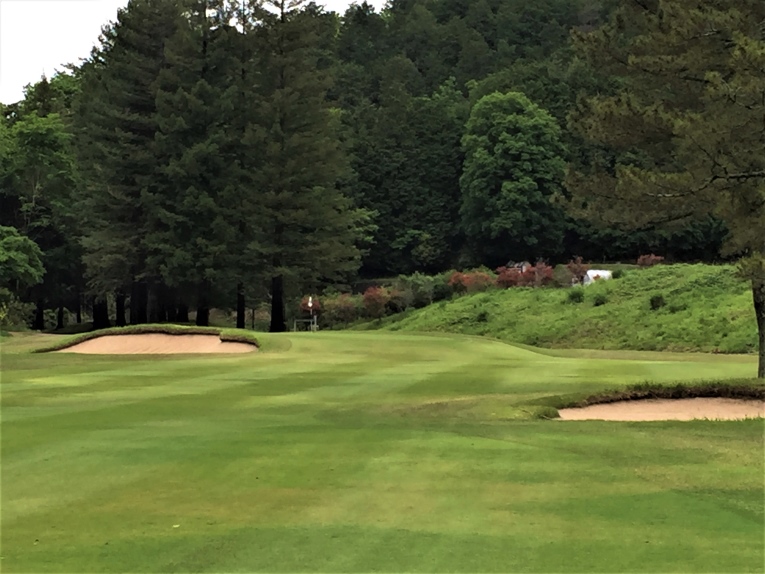Naruo Golf Club
Kawanishi, Hyogo, Japan
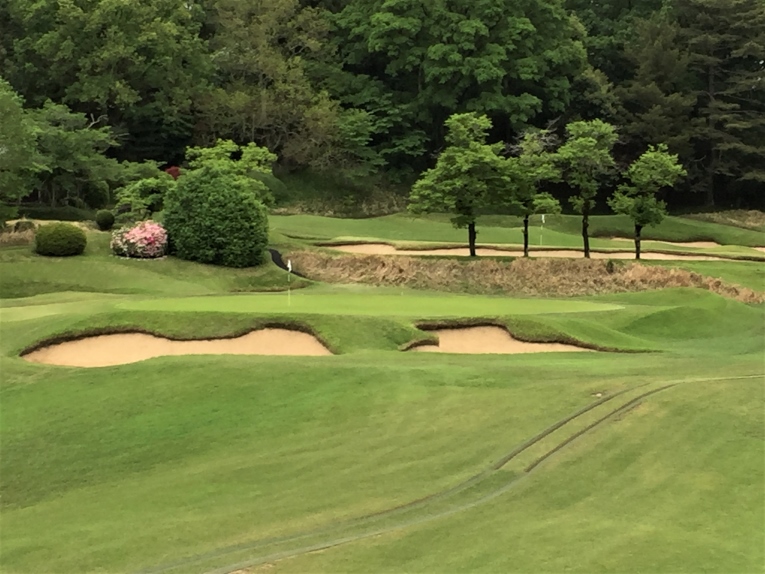
A very fine eighteen hole course was laid out by the Crane brothers between 1929 and 1930 that was made great by subsequent work based on the recommendations of C.H. Alison in January, 1931.
In the days of the Golden Age of Architecture many of the master architects did their finest work near their homes: Donald Ross in North Carolina and Massachuesetts, George Thomas in southern California, C.B. Macdonald near New York, Harry Colt in England, Perry Maxwell on the midwestern plains, A.W. Tillinghast in the Northeast; the list goes on and on. Two glaring exceptions exist; Alister MacKenzie famously tour ofAustralia and New Zealand and Charles Hugh Alison’s foray to Japan. Both sojourns were measured in weeks and months opposed to years and neither man saw any of his designs through to completion but both visits were transformational to the core of their respective regions.
Though MacKenzie and Alison had markedly different personae, they shared many similar design tenets. No surprise, considering that they briefly worked together under the shingle of Harry Colt. All three shared an overriding conviction that good architecture centered on asking the golfer to accomplish something while cocooned in nature. They all moved dirt to create appealing hazards and targets but the overall sense of their works is that the holes rest peacefully on the landscape. Ultimately, Australia/New Zealand and Japan became the beneficiaries of this brand of golf and were extremely fortunate that the bar was set to such an exacting standard.
For the author, the single finest read to better understand Alison’s time in Japan is found (not surprisingly!) at GolfClubAtlas.com and penned by Tom MacWood. Click here to see his Gliding Past Fuji – C.H. Alison in Japan which explores golf’s evolution in the Land of the Rising Sun. Based in Columbus, Ohio, MacWood died far too young in 2012 but much of his pathbreaking research survives on GolfClubAtlas. Regarding Alison, MacWood succinctly set the stage with his opening paragraph:
“Gliding past Fuji, still snow-capped, the luxurious Asama Maru passes accurately among a thousand sampans and comes to a rest alongside a modern quay.” This is how golf architect CH Alison described his entrance into Tokyo Bay. A disciple of a movement in golf design that began outside London and spread through the Western world, Alison was the first and only golf architect of that sect to set foot in Asia. Invited to Japan in 1930, he brought a philosophy of architecture born on the natural links and melded it perfectly with the Japanese aesthetic to produce an enduring legacy. The impact of his short visit was so forceful that seventy years later it remains the dominant influence on design in that golf crazed nation.”
He goes on to note:
Charles Hugh Alison was no golf design neophyte. Born in Lancashire, England in 1883, he had been educated at Malvern and Oxford. Better known for athletics than academics, Alison excelled at both cricket and golf. He was the youngest member of the Oxford and Cambridge Golf Society’s team, captained by John Low, which toured America in 1903. Following a short career in cricket and golf journalism, Alison became the secretary of the new Stoke Poges Golf Club in 1907, a Colt design in the London outskirts. It is believed he dabbled in design while serving as secretary, but he didn’t devote himself completely to golf architecture until after WWI – going into partnership with Colt and Alister MacKenzie. Almost immediately he was dispatched to America where he worked throughout the twenties, producing a number of impressive designs, including Kirtland, Fresh Meadow, Burning Tree, North Shore, Century, CC of Detroit, Timber Point, Sea Island and Milwaukee. With economic difficulties affecting American work, the Japanese project presented an exciting opportunity.
Recently there has there been a renewed appreciation of Alison’s work and some of his best designs like Milwaukee, Century, Kirtland and Orchard Lake have completed superlative restorations that identify Alison’s genius as an architect. Other courses, like Davenport CC in Iowa, are coming onto the radar screen of the cognoscenti. Also, consider that Alison’s undisputed masterpiece, Timber Point on Long Island, is a mere shell of its former glory. If you removed National Golf Links of America from C.B. Macdonald’s portfolio, how much would his reputation suffer?! The preponderance of critics who opine on the merits of golf course architecture come from North America or the United Kingdom and Ireland. How many of these critics have seen Alison’s work in Japan and are able to offer a complete, informed assessment? It is a similar to judging Tom Doak’s body of work without visiting Australia and New Zealand.
Alison is responsible for as many as nine courses (Hirono, Kawana, Milwaukee, Kirtland, Sea Island, Timber Point, Tokyo, Kasumigaseki and Naruo) that have rightly claimed consideration for the World Top 100! Like Milwaukee, where a course already existed, Alison unmistakably stamped Naruo with his unique brand of brawny bunkers and thought-producing greens. In Japan, Alison gained such great fame for the depth and size of his bunkers that large bunkers are regularly referred to as ‘Allisons.’ Naruo’s single most compelling design feature is its artfully presented, well-placed and uncompromising bunkering. To the author’s eye, the course is among the dozen most relentlessly, handsomely bunkered courses in the world. ‘Allisons’ enliven the rambunctious property with great golf quality.
MacWood details his thoughts on Alison’s bunkers:
Not only were his bunkers deep – both greenside and fairway – they were also very large in scale. Alison’s greenside bunkers were frequently as large as the greens they guarded. He often elevated the green well above the approaching fairway or tee, bunkers were then cut well below the elevation, in effect increasing their depth. Fairway bunkers were placed against or below mounding, also increasing their effective depth. And he was not opposed to an occasional forced carry — usually with bunkers set at a diagonal, allowing for choice and rewarding the bold play.
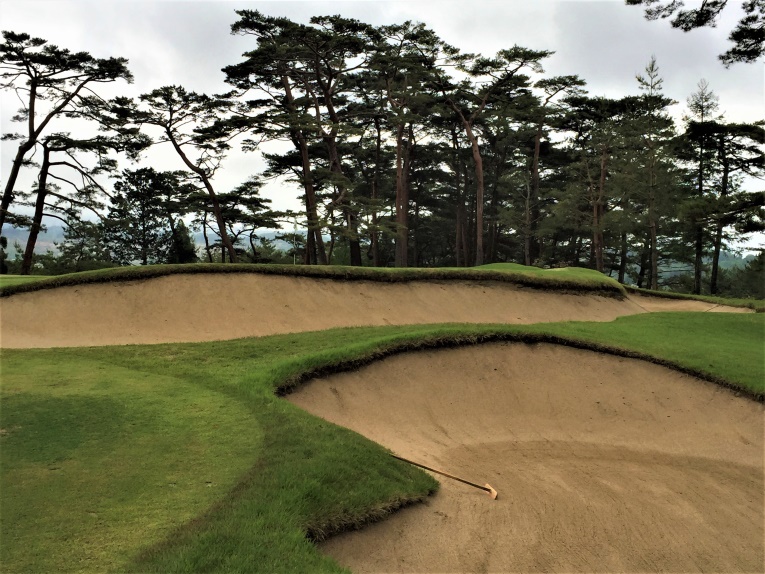
Naruo’s bunkers have been so beautifully and painstakingly presented for decades that they deserve to be heralded around the world.
Given that Alison was in Japan for only three months, how did such sterling work get accomplished after he’d left? MacWood discovered that … “Alison wrote very detailed descriptions of how his design features should appear. His mounding was to have a ‘broken horizon’ and his bunkers were to have the sand ‘splashed’ up to point where it met a band of native soil and the grass of the mound. He referred to this meeting of sand and grass as ‘rivetting’ – although he did not use the term in its classic sense – and it was to have an uneven outline. (Many of his bunkers in the US now have grass facing, with little or no flashing and are very regular in outline). In his construction notes he constantly uses the term ‘irregularizing’ — a clear acknowledgment of the irregularity found in nature. Although Alison often created features that were clearly artificial there is something aesthetically pleasing about them; he had a gift for creating man-made features that sympathized with the natural.”
Naruo’s wonderful, character-laden property is highlighted by how the holes fall across the land (courtesy of Joe, Harry, and Bertie Crane) and is punctuated with the wonderful bunkers that they implemented based on Alison’s outline. While the greens lack the swoop of MacKenzie’s work at Kingston Heath and Royal Melbourne, they are appealing, well-defined targets of medium to small size. Korai grass, unique to Japan, constitutes the putting surfaces and harkens back to the challenges of common Bermuda greens when both knowledge and skill was required to read grain and a pace that rarely approached the swiftness of the glass-like greens in Australia. Mostly, it’s the orientation of the greens to the fairways and the bunkering schemes that provide playing interest from the fairway and not internal green contours. It’s an old fashioned challenge of the sort that regrettably is eschewed by modern architects.
Holes to Note
First hole, 395 yards; Nothing beats an opener that conveys a true sense of place. Immaculate ornamental plantings around the first tee complex exude the tranquil ambience of a Japanese garden. Ahead, the golfer sees an intelligent bunker pattern (e.g. fairway bunker left, greenside bunker right) denoting that the task is to head left off the tee. That is made abundantly clear upon arrival at the medium-sized, angled green. Only 26 yards deep and some 3,900 square feet, the green is indicative of the accuracy that will be required of your approach shots the entire round. A tightly mown left back run off is a recent addition. Shaping shots to find and hold fairways and distance control are paramount at Naruo. The author finds this incredibly refreshing, believing that the pendulum has swung too far toward senselessly wide fairways and billowing, massive greens. A round at Naruo is a tactical exercise in positional golf, one in which precision and clear thinking trump brute length. The first hole epitomizes such.
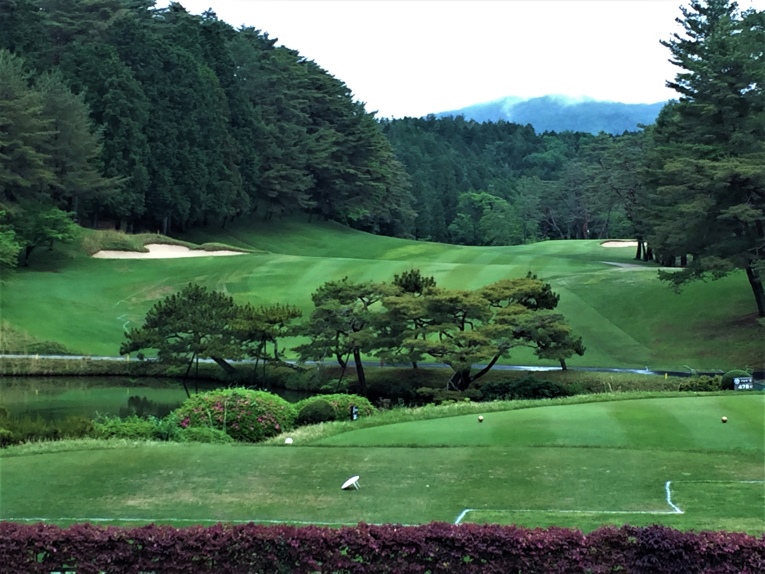
The appealing prospects off the 1st tee. As he did here, Alison counseled that the fairway be widened on several holes.
Second hole, 180 yards; Beautifully routed, this one shotter utilizes a peninsula of land for the well-bunkered green that features sharp drop-offs left, right and behind. It is a given (almost a cliché at this point) that if there is Alison, there is a great set of par 3s. Bear in mind that he didn’t route this course but focused on refining the bunkering and green complexes. Culturally, the Japanese love well-tended trees and those along the banks of the landform that the green occupies are no exception. While attractive, the author wonders what the sensation would be to play to this green if it was more exposed? Whipping wind and elongated views might lend even more charisma to an already noteworthy hole.

Alison suggested to “make a 5 ft deep bunker to the left of the green side and 3 ft deep pot on the right side.”
Third hole, 400 yards; Naruo provides a number of interesting propositions off the tee, with the most common being the intrusion of hillsides into the line of play. Here, the confident golfer flights his ball left, over leaning trees on the brow of a hill on the direct line to the green to shorten his approach. More cautious players aim to the visible fairway ahead before tacking to the left for their (longer) approach.

The tenth green is the distance straight ahead and the third green is marked by the greenside bunker underneath the leaning pine tree. Does the golfer have the nerve to flight his tee ball over the tree and hillside?
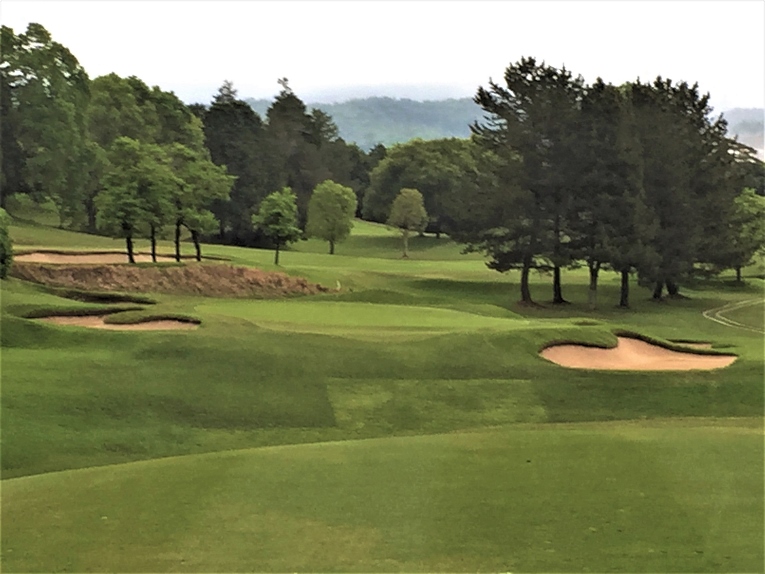
A bold tee shot left leaves this ideal approach. Golfers who play ‘safely’ to the right from the tee face an approach over the deep, right fronting bunker.
Fourth hole, 205 yards; Most of Japan’s courses including Tokyo, Kawana, and Kasumigaseki embraced a two green system. Initially, the purpose was to have summer grass on one and winter grass on the other but advances in agronomy have made clubs re-consider the practice. At Naruo, only this hole and the fourteenth have double greens. Land movement in this region is much more exciting than around Tokyo and two green sites that could be of equal appeal were never a practical consideration.
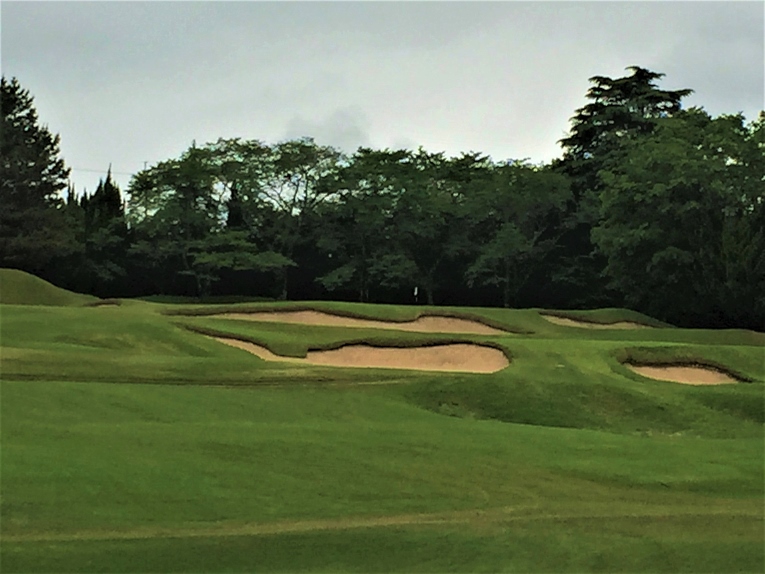
As seen from Alison’s tee, Alison’s green is in the foreground while the ‘new’ green with today’s flag is in the distance. Championship play is from Alison’s tee uphill to the new green and requires a stout blow.
Fifth hole, 395 yards; Holes that create dissension in terms of how they are best played always intrigue. Here, out-of-bounds looms uncomfortably to the left and the fairway bends softly that way. A draw off the tee can catch the downslope and scoot an extra 30 yards toward the green. While there’s appeal for a short approach, the green is at an angle and well above the golfer. Another strategy has the player lay back off the tee and play to the right where there is a flat plateau guarded by a solitary fairway bunker. From there, the golfer is rewarded with a look down the long narrow green. Which route do you prefer? Certainly, the answer can change based on the day’s playing conditions.

The shortest path is over the red bush but be mindful of the out-of-bounds left. Alternatively, carry the fairway bunker on the right with a shorter club off the tee and be left with this ….
Seventh hole, 525 yards; Locals describe this as their ‘left, right, left’ hole which tells you that a zigzag path will yield the best results over a playing season. Accessing the green from the right is paramount but a stream, fairway bunkers and a diabolical tree are found there. Featuring a plethora of standout two shot holes, there are but a pair of three-shotters at Naruo. Both are reachable in two by the tiger but are amply defended at the green. Here, a minor miracle is required to hit and hold the minuscule, kidney-shaped green from 200+ yards out. It’s too bad more architects don’t build small greens to deter bombers from relentlessly attacking three shot holes.

Nestled in its own secluded valley, the 7th asks the golfer to steer left of the fairway bunker that Alison prescribed. And …

As seen from behind, the 7th putting surface is only 10 paces deep at the back left. Such hole locations go a long way in protecting the integrity of par on a sub-530 yard hole.
Eighth hole, 435 yards; Along with Alison, the lion’s share of the credit for Naruo lies with the Crane Brothers who found this property and routed today’s eighteen holes after the club was forced to relinquish land from its original site thirty minutes away in 1929. The Cranes enlightened decision to route the seventh, eighth and ninth holes around the base of a large landform was a master stroke. Never satisfied, the Cranes wanted what was best for the club and when Alison’s presence in Japan was made known, they eagerly invited him to consult at Naruo’s ‘new’ one year old course. Alison’s suggestions were implemented and enhanced the Cranes’ work, providing the platform for Naruo’s long, distinguished history. That Arnold Palmer, Jack Nicklaus and Gary Player once played a match here defines the stature that the club enjoys in Japan. Maintaining a card tough enough to match Old Man Par is no easy standard for a course that measures just over 6,600 yards. It helps that there are only two par fives creating a tight par of 70. Read any review of the course and words like ‘difficult’ and ‘testing’ still predominate. How can that be? Examine this hole where the club recently built a new back tee that added an additional 30 yards. Its length is measured around the dogleg but the play is to the outside of the bend (as we see below) where you cover more like ~450 yards and the second half of the hole climbs a slight grade. Eight joins the tenth and eighteenth as anchors to test the best. The average club member (age 70) is free to treat this hole as a three-shotter as even the most limber golfer will struggle to get home in two. Par is safe at Naruo.

The temptation on any hole that swings left is try and gain an advantage by hugging the inside corner with one’s tee ball. In this case, that might not …
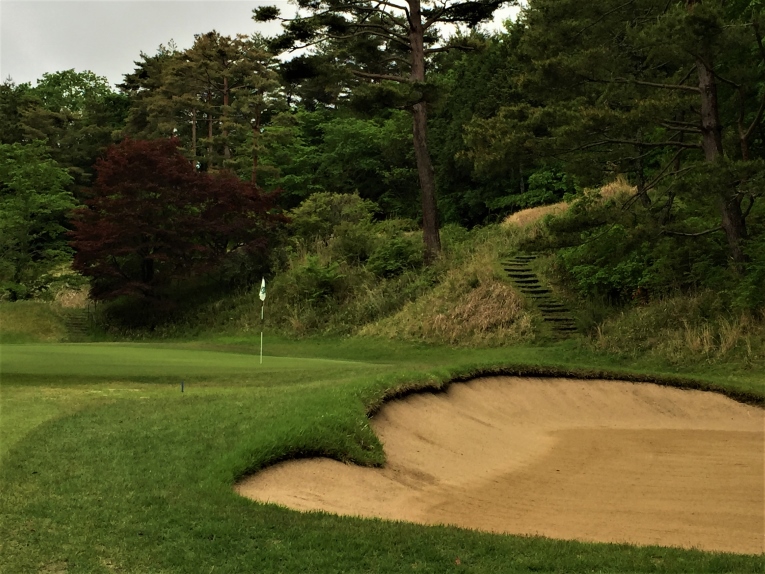
There are a number of attractive backdrops to the greens at Naruo and the 8th is one of the most handsome in terms of texture and color.
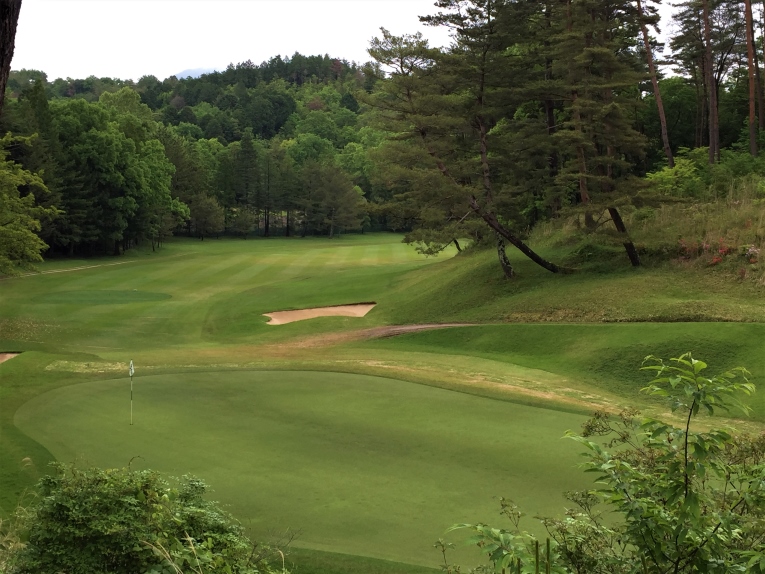
As seen from above on the ninth tee, the golfer appreciates how the angle of the green and the intrusion of the tree necessitate play from the outside of the dogleg.
continued >>>
Naruo Golf Club
Kawanishi, Hyogo, Japan
Ninth hole, 385 yards; If anything, advances in technology are making Naruo more interesting. Golfers are tempted to take more aggressive lines off tees and to flirt with difficult hole locations, even if they short-side themselves. Take this hole that bends around the shoulder of a hill. Modern equipment practically begs the golfer to have a slash up and over the hillside. Facing a risky taunt and pulling it off is quite satisfying for any golfer and the more visually intimidating, the greater the pride. Ahead, the downhill short iron approach might have the golfer licking his chops but the slightest pull will find him ruefully over the narrow green in a back bunker.
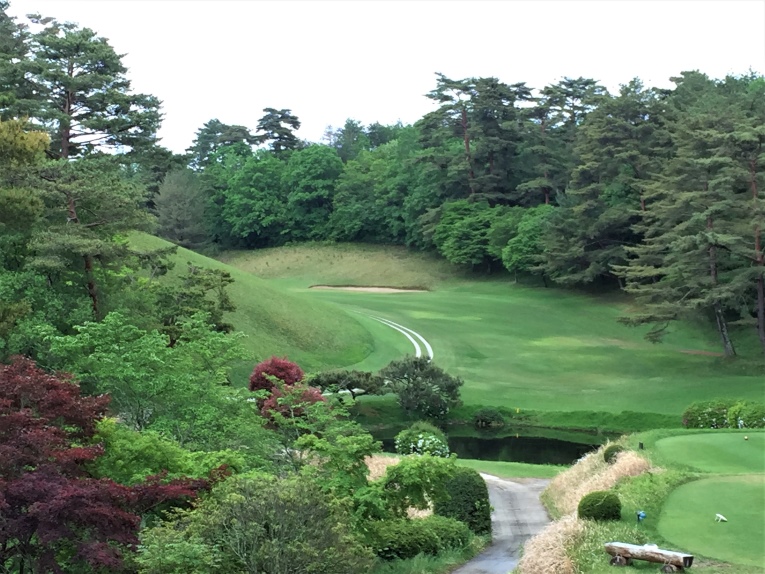
From the back markers, the single digit club golfer is likely to play at the distant fairway bunker with a draw.
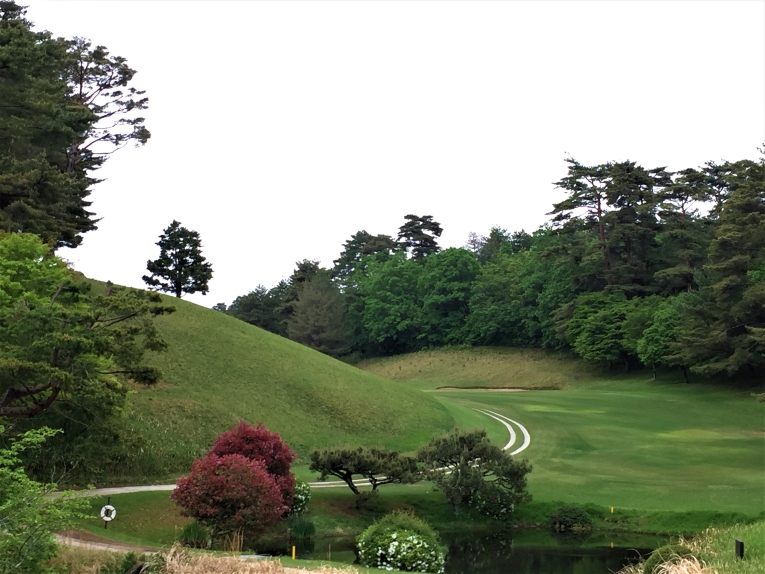
Should he play from one set forward, the option becomes to aim over the lone pine tree on the hillside with a driver.

Finding the fairway and hitting from short grass is important as the green is ringed by six bunkers and …
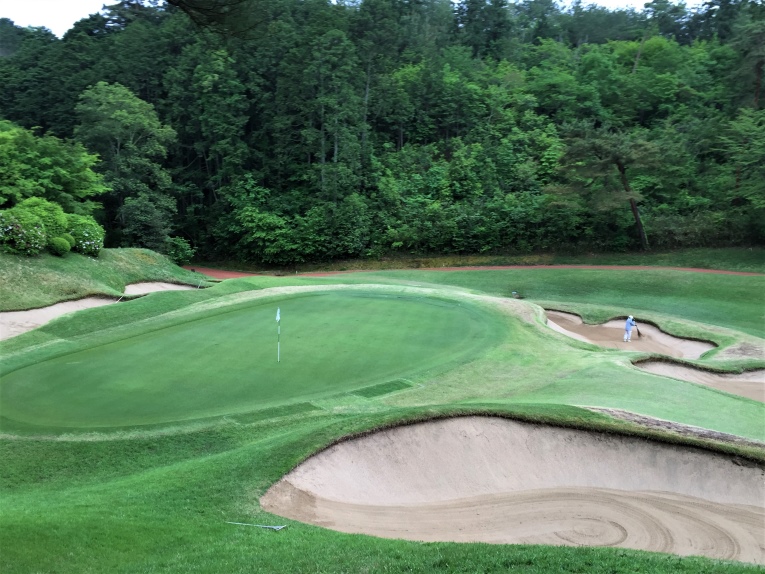
… as seen from high left of the green, the putting surface is much wider than it is deep. The left side of the green is a scant eleven paces deep.
Tenth hole, 475 yards; Some holes are long, hard and boring (tune into the PGA for weekly examples) and some holes are long, hard and thrilling (look for Golden Age par 5’s that are now par 4s). This one falls into the latter category and notably, George Peper et al. selected it as one of the world’s top 500 holes. Similar to the eleventh at Ballybunion and the fourteenth at Olympia Fields, the mammoth hole is laid out in plain view of the golfer so lack of awareness isn’t the culprit for a mounting score. Rather, it’s the cruelty of having to cross so much exciting land in but two shots that taxes even the smoothest swing.
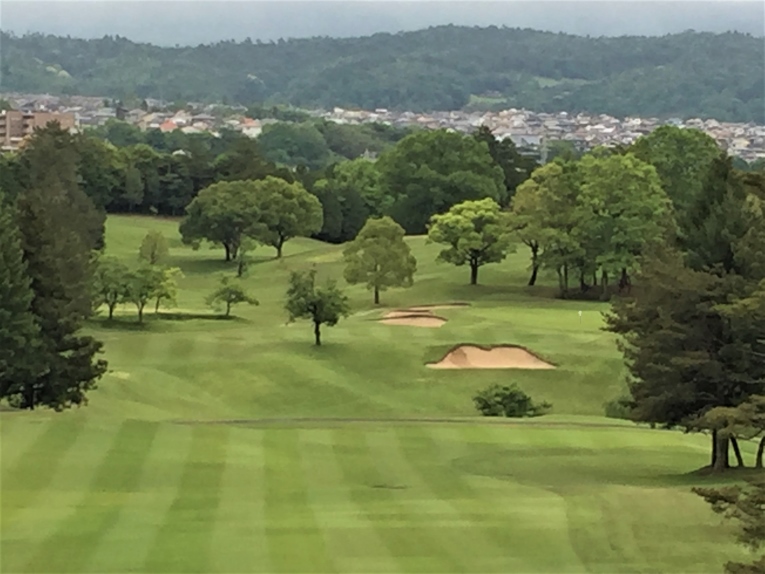
This gorgeous view from the 10th tee becomes daunting when the golfer realizes he is only given two strokes to cover the distance.
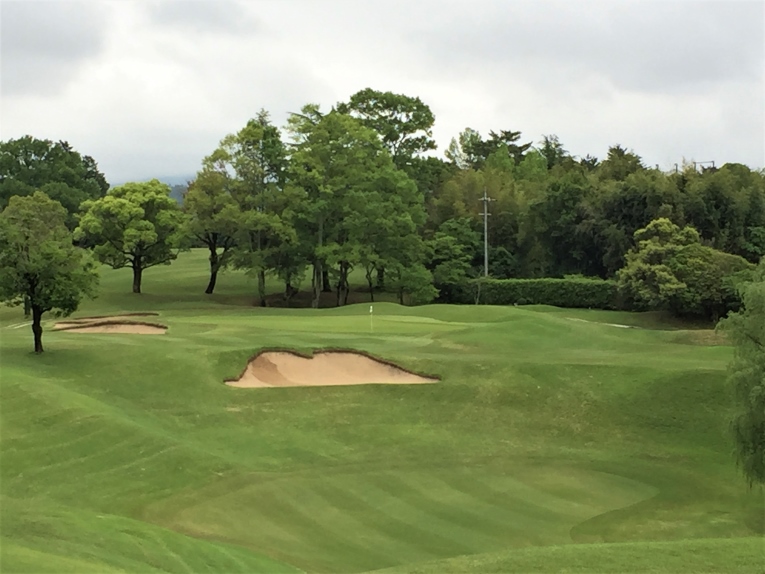
The 200+ yard approach across a bygone river valley is as thrilling and heroic as the downhill tee shot.
Twelfth hole, 165 yards; Alison’s original design partner, Harry Colt, famously placed great emphasis on one shot holes. Colt never traveled to Japan but if he had, he would have marveled at the top to bottom excellence of the one shotters at both Naruo and Hirono. Of the eight, none are remotely indifferent and half can be deemed world-class (Naruo 12, 15 and Hirono 5, 7).
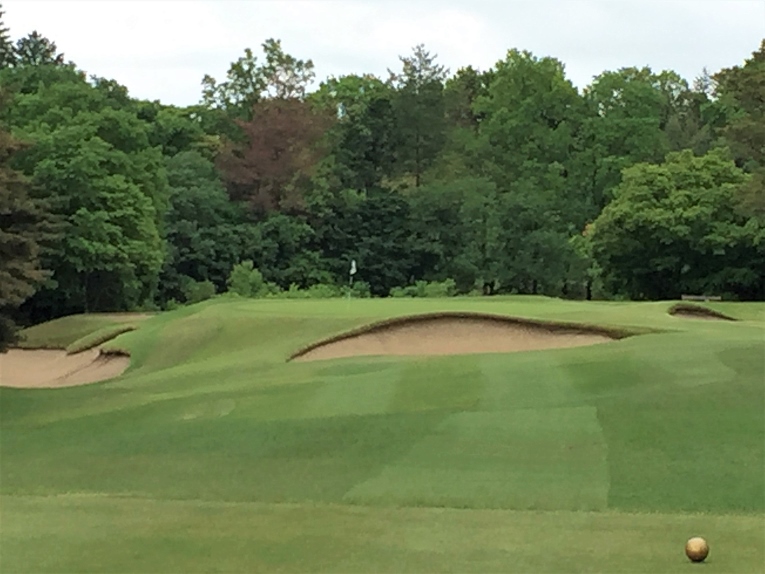
The left greenside bunker is the deepest on the course and balls with a bit too much draw can hit on the putting surface and tumble fifteen feet to an unlikely recovery.
Fourteenth hole, 485 yards; Given the bruising four hole finish, the pressure is exacerbated for the good golfer to take advantage of this hole’s modest length. A calm before the storm, the golfer stands on the tee and sees clear-sailing down a bunkerlesss, sloping fairway. However, the drama greatly increases 100 yards from the green, where a ravine slashes diagonally between the fairway and green.
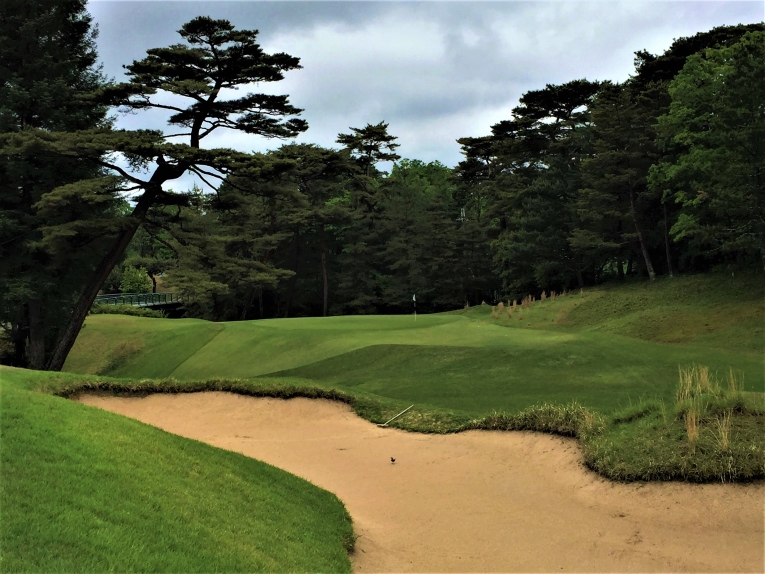
The presentation of the green, particularly the tight grass that feeds down the precipitous drop-off, is first rate. It would be infinitely easier, duller and less scary if the greenside bank was rough and retained balls on its slope.
Fifteenth hole, 190 yards; The Cranes had positioned this tee close to the fourteenth green and their hole appears to have been fairly prosaic and uphill. Alison suggested – and they agreed – to move the tee to the other side of the entrance drive creating a much longer hole played over a ravine. Alison’s brainstorm rivals the tenth as the most famous hole on the course and is certainly a case study of a great architect producing a great hole. The none-too-deep (24 yards), circular green is virtually an island surrounded by a sea of sand. It’s easy to see how the better ball striker eventually wears out the golfer who has to scramble for his pars at Naruo; getting up and down from these bunkers is one mean feat.

Eight bunkers engulf the green, positioned a good half club above the teeing ground. The club’s winding entrance road is between the tee and green, down in the ravine.
Sixteenth hole, 405 yards; The well-traveled golfer might be reminded of the Inverness Golf Club in Ohio where the back nine features a series of parallel two shotters and a lone three shotter that utilize the land in such diverse ways as to make the golfer forget that the holes are parallel. At Nauro, the fourteenth, eighteenth, seventeenth, sixteenth and thirteenth holes play in parallel tree-lined corridors but like Inverness, the land and resultant challenges are wildly different.
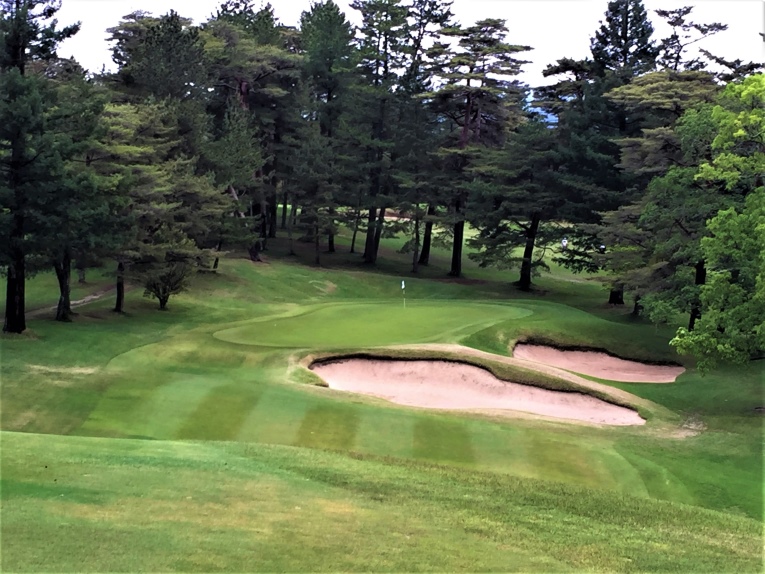
The approach shot to the 16th drops majestically some fifty feet across broken ground. As per usual, the green complex dictates a preferable half of the fairway for the approach. It is telling that Alison had the fairway extended 15 yards to the right, as a means of using short grass to help get the golfer out of position.
Seventeenth hole, 400 yards; Diversity is the hallmark of any great course and Naruo possesses it in spades. Just look at the last few approach shots: carry over a ravine to the bunkerless fourteenth green, uphill tee ball at the one shot fifteenth surrounded by sand, downhill approach to the long, angled sixteenth, and now an uphill second to a small, circular green atop a hill. Fourteen, sixteen, and seventeen parallel one another – but you would never know it!
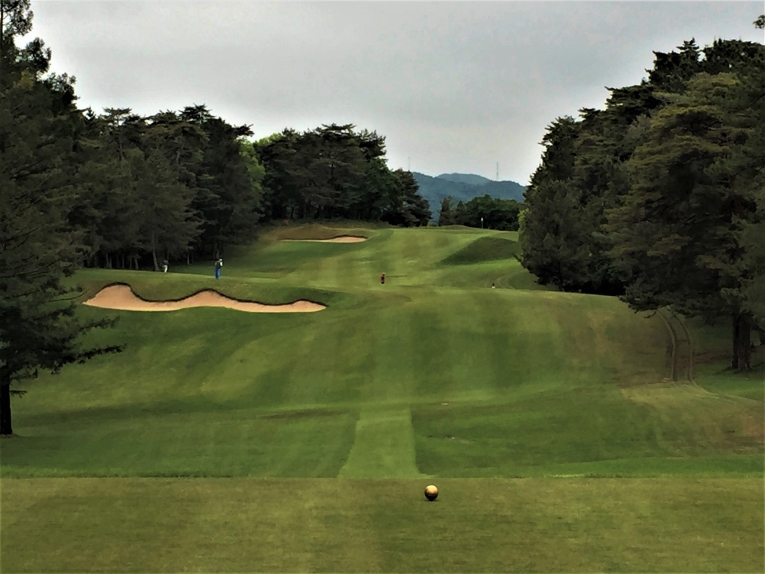
A drive over the right half of the fairway bunker does nicely. What dreamy landscape for golf and when Alison recommended cutting bunkers into such natural landforms, they were guaranteed to be deep.
Eighteenth hole, 455 yards; The course, like Oakmont, concludes with a downhill tee ball to a fairway where the going is more level. A cross bunker 110 yards short of the green and one of the course’s best contoured putting surfaces cap off the round in a demanding fashion. An expansive long view from the tee of the distant hills sometimes shrouded in clouds is always one to savor.
After the round the golfer is bound to reflect on all the pleasurable shots he faced. Off the tee or into the greens, many shots readily appeal and are of the sort that the golfer is keen for another try. There are no weak links and losing a ball is a rarity. Play is always with a caddie, who transports your clubs on a motorized trolley. Pausing for lunch is de rigor.
Originally, the club began life some 30 miles away in Naruo-hama (Naruo-beach) as a three holer with sand greens but quickly became 6 then 9 and finally 18. A financial depression necessitated the sale of some of the land and the Crane brothers (who were club members) scouted around and secured this wonderfully rolling site in 1929. Joe, Harry and Bertie clearly had a keen eye for what constitutes good golf and their design opened October 12, 1930. Fortuitously, Alison was in the area during his famous journey and the Cranes selflessly solicited his advice to help them refine the holes and take Naruo to an altogether higher level.
Alison’s notes were concise and centered around moving tees, expanding playing corridors, adding bunkers and adjusting greens. Ultimately, it’s the greens, the final targets whose quality does as much to define an inland course as any other attribute. Alison excelled at that and his plans were executed by the same talented hands that shaped the course. Tom MacWood’s admiration for C.H. Alison is well-founded and here is how he surmised Alison’s green construction:
Greenside mounds would often encroach upon the putting surfaces. This was Alison’s preferred method of creating undulations in his greens, extending and merging either natural undulations or mounds onto the green surfaces. And like many designers his greens were oriented to one side or the other through the placement of greenside hazards or pronounced contours, rewarding those who chose the best angle of attack (occasionally the center was the preferred approach). Another common device was the tilting of his greens sideways — an approach from the wrong angle or one poorly struck would fall away.
There is abundant strategy here and advantages can be gained on every shot so that the thinking golfer is bound to fall under Naruo’s considerable spell. The members are extremely fortunate to have such a thought-provoking design to enjoy on a regular basis.
The End



